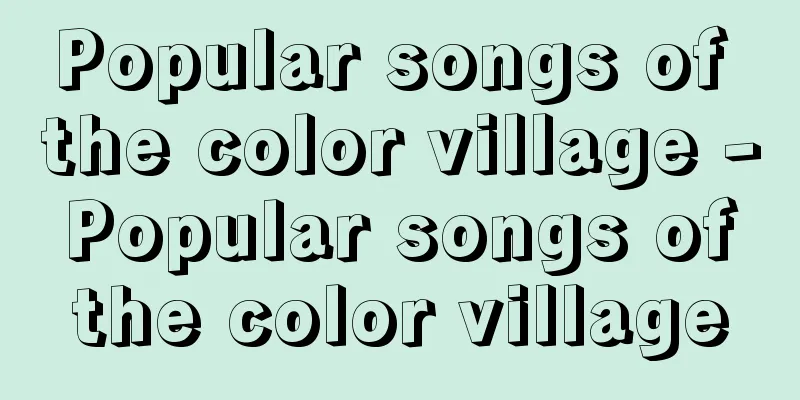Popular songs of the color village - Popular songs of the color village

|
...Starting with Takatatsu-bushi, around the Kan'ei period (1624-44), Rosai-bushi became popular in Kyoto, Katabachi in Edo, and in the Meireki and Manji periods (1655-61), Nage-bushi in Shimabara, Kyoto, Tsuki-bushi in Yoshiwara, Edo, and Magaki-bushi in Shinmachi, Osaka. Although the melodies of all of these are unclear, since kouta were first sung in red-light districts, they later came to be collectively called "red-light district popular songs." The "Kabuki Kotohajime" (1762) lists the names of the composers and singers of kouta, but the titles of these kouta songs include today's jiuta and nagauta, so the concept of kouta may have been used in opposition to the narrative-based joruri. ... *Some of the terminology used in reference to "Irozato Popular Songs" is listed below. Source | Heibonsha World Encyclopedia 2nd Edition | Information |
|
…隆達節を端緒として,寛永(1624‐44)ころには京都で弄斎節(ろうさいぶし),江戸で片撥(かたばち),明暦・万治(1655‐61)には京都島原で投節(なげぶし),江戸吉原でつき(ぎ)節,大坂新町で籬(まがき)節などが流行する。いずれも旋律は明らかではないが,小歌は色里から歌い出されたので,のちには〈色里流行歌(はやりうた)〉と総称されるようになる。なお《歌舞妓事始》(1762)には,小歌の作者や歌手の名前が記されているが,その小歌の曲名はこんにちの地歌や長唄をも含むから,小歌という概念は,物語性のある浄瑠璃と対立して用いられていたのかもしれない。… ※「色里流行歌」について言及している用語解説の一部を掲載しています。 出典|株式会社平凡社世界大百科事典 第2版について | 情報 |
Recommend
Ossietzky, C. von - Teaching
…The main targets of his criticism were the burea...
Children's magazine - Jidou Zasshi
A periodical that publishes educational and entert...
Parasol mushroom - Parasol mushroom
...It is distributed widely throughout the world,...
Cuba - Cuba (English spelling)
Cuba is a country that consists of Cuba, the larg...
Porridge tree - Kayunoki
① = Kayu-zue (rice porridge stick) ※Makura (end of...
Douglas Reef
…The southernmost island in Japan (20°25′N, 136°0...
Mindaugas; Mindowe
[Birth] Around 12:00 [Died] 1263 King of Lithuania...
《Diese Woche》(English spelling)DieseWoche
…Published by Rudolf Augstein (Hamburg). It is th...
Skhul man
Human bones excavated in S'Hour Cave, one of t...
Julian Bream
1933‐ British guitar and lute player. While studyi...
Beckmann rearrangement
A reaction in which a ketone oxime is reacted wit...
Masashige Inoue
Year of death: 27th February 1661 (27th March 1661...
Papal Imperialism
A theory on papacy advocated by Pope Gregory VII (...
Yunomineshida - Yunomineshida
A perennial fern of the Acanthaceae family. It is ...
Saprophages
…Dung contains a large amount of organic matter, ...









